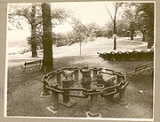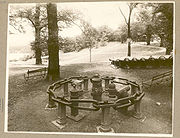
Stirling Iron Works
Encyclopedia
The Sterling Iron Works owned by Peter Townsend was one of the first steel and iron manufacturer in the American colonies and the first steel producer in the colony of New York. The company was most famous for forging the Hudson River Chain
that kept the British Navy from sailing up the Hudson during the American Revolution, and served to protect the strategically important fort at West Point. The works were operational from 1761 to 1842.
The Long Mine, belonging to the Townsends, was discovered in 1761 by David Jones and supplied about 500 tons of ore annually to the Sterling Works over the next 70–80 years for an aggregate production of about 140,000 tons. It was the only mine at which systematic mining was attempted in that time, and was worked to the depth of 170 feet (51.8 m) on a single vein 6 feet (1.8 m) thick. The ore yielded 62 per cent, of strong tough metal, from which cannon, muskets, wire, steel, fine malleable iron, and harness-buckles were made.
The Mountain Mine, half a mile southwest of Long Mine, was found in 1758 by a hunter, in consequence of a tree having been blown up by he roots. The Iron from this mine was remarkable for its strength and fine polish, and was in consequence chiefly exported to England to be tinned.
and afterward from bar iron. The first blister steel made in the State was made by his son, Peter Townsend, Jr., in 1810, from ore of the Long Mine on the Stirling estate. In the manufacture of edge-tools it was considered equal to the famous Dannemora mine
Swedish Iron.
The first cannon made in the State were cast at Stirling for the government, in 1816. They were from six to thirty-two pounders.
 At the close of 1779, West Point was the strongest military post in America. In addition to the batteries that stood menacingly upon the hill tops, the river was obstructed by an enormous iron chain. The iron of which this chain was constructed was wrought from ore of equal parts, from the Stirling and Long Mines, in Orange county. The chain was manufactured at the Stirling Iron Works about 25 miles (40.2 km) from West Point. The general superintendent of the work, as engineer, was Captain Thomas Machin, who afterward assisted in the engineering operations at Yorktown, when Cornwallis was captured. The project took place under the supervision of Colonel Timothy Pickering
At the close of 1779, West Point was the strongest military post in America. In addition to the batteries that stood menacingly upon the hill tops, the river was obstructed by an enormous iron chain. The iron of which this chain was constructed was wrought from ore of equal parts, from the Stirling and Long Mines, in Orange county. The chain was manufactured at the Stirling Iron Works about 25 miles (40.2 km) from West Point. The general superintendent of the work, as engineer, was Captain Thomas Machin, who afterward assisted in the engineering operations at Yorktown, when Cornwallis was captured. The project took place under the supervision of Colonel Timothy Pickering
.
The chain was completed in the middle of April, 1778, and on the 1st of May it was stretched across the river and secured. It weighed 186 tons, and was made and delivered in six weeks. This chain was forged at Stirling, hauled piece by piece to New Windsor, and put together at the military smithy of Capt. Machin. It was then floated down the Hudson as a whole, and placed in position. It remained unbroken during the war although others at Fort Montgomery and on the lake above were broken by the British. Links of these chains, weighing 140 lb (63.5 kg). each, are preserved at the Military Academy at West Point.
In front of this chain was a heavy boom of logs. Each winter the chain and boom were un-moored, taken up to the beach, in the cove now crossed by the railroad tracks, and piled up out of reach of the moving ice until ready to be replaced in the spring.
The chain was instrumental in the discovery of Benedict Arnold
, when Peter Townsend's cousin, Sally Townsend, whose brother Robert was a member of Gen George Washington's Culper Ring
of spies, allegedly intercepted information at the family home in Oyster Bay, Long Island which occupied by British officers. The intercepted message from Arnold indicated that he had weakened the chain and contained instructions on how the Royal Navy could breach its defenses and take the fort at West Point. When he realized he had been discovered, Arnold escaped to the British and the chain remained intact throughout the war.
Hudson River Chain
The Hudson River Chain may refer to any of several chains used as a blockade across the Hudson River intended to prevent British naval vessels from proceeding up the river during the American Revolutionary War.-The Great Chain :...
that kept the British Navy from sailing up the Hudson during the American Revolution, and served to protect the strategically important fort at West Point. The works were operational from 1761 to 1842.
Initial ore discovery
In 1750 the first discovery was made of a rich superficial deposit of iron ore at the south end of Sterling Mountain, in the town of Monroe, New York. In the following year, Ward & Colton erected at the outlet of mine and Sterling Pond, in the extreme southern part of Warwick, near the Monroe line, a charcoal blast-furnace, which was the first in Warwick. These works were called the Sterling Iron-works, honoring General William Alexander, Lord Stirling, the owner of the land, and later an officer in the Revolutionary army. They were built for the manufacture of anchors, including for the United States frigate, . A second Sterling furnace was built in 1777.Additional mines opened
Several other veins of magnetic ore were later opened in the vicinity of the Sterling mine, which itself covered about 30 acres (121,405.8 m²). The Forest of Dean mine, a very extensive bed six miles (10 km) west-northwest of Fort Montgomery, as early as 1756 supplied a furnace, and was abandoned twenty-one years later. The vein is over 30 feet (9.1 m) thick and 150 feet (45.7 m) broad, and made good cold short iron.The Long Mine, belonging to the Townsends, was discovered in 1761 by David Jones and supplied about 500 tons of ore annually to the Sterling Works over the next 70–80 years for an aggregate production of about 140,000 tons. It was the only mine at which systematic mining was attempted in that time, and was worked to the depth of 170 feet (51.8 m) on a single vein 6 feet (1.8 m) thick. The ore yielded 62 per cent, of strong tough metal, from which cannon, muskets, wire, steel, fine malleable iron, and harness-buckles were made.
The Mountain Mine, half a mile southwest of Long Mine, was found in 1758 by a hunter, in consequence of a tree having been blown up by he roots. The Iron from this mine was remarkable for its strength and fine polish, and was in consequence chiefly exported to England to be tinned.
First metal produced in New York
Mr. Peter Townsend, who became the owner of Stirling Iron before the Revolutionary War, made iron anchors in 1773, and in 1776 produced the first steel in New York, at first from pigPig iron
Pig iron is the intermediate product of smelting iron ore with a high-carbon fuel such as coke, usually with limestone as a flux. Charcoal and anthracite have also been used as fuel...
and afterward from bar iron. The first blister steel made in the State was made by his son, Peter Townsend, Jr., in 1810, from ore of the Long Mine on the Stirling estate. In the manufacture of edge-tools it was considered equal to the famous Dannemora mine
Dannemora mine
The Dannemora mine at Dannemora, Sweden was one of the most important iron ore mines in Sweden. The mine was closed by its owners SSAB in 1992. It may have been open since the 13th century, but the first documentary reference was in 1481...
Swedish Iron.
The first cannon made in the State were cast at Stirling for the government, in 1816. They were from six to thirty-two pounders.
The Hudson River Chain

Timothy Pickering
Timothy Pickering was a politician from Massachusetts who served in a variety of roles, most notably as the third United States Secretary of State, serving in that office from 1795 to 1800 under Presidents George Washington and John Adams.-Early years:Pickering was born in Salem, Massachusetts to...
.
The chain was completed in the middle of April, 1778, and on the 1st of May it was stretched across the river and secured. It weighed 186 tons, and was made and delivered in six weeks. This chain was forged at Stirling, hauled piece by piece to New Windsor, and put together at the military smithy of Capt. Machin. It was then floated down the Hudson as a whole, and placed in position. It remained unbroken during the war although others at Fort Montgomery and on the lake above were broken by the British. Links of these chains, weighing 140 lb (63.5 kg). each, are preserved at the Military Academy at West Point.
In front of this chain was a heavy boom of logs. Each winter the chain and boom were un-moored, taken up to the beach, in the cove now crossed by the railroad tracks, and piled up out of reach of the moving ice until ready to be replaced in the spring.
The chain was instrumental in the discovery of Benedict Arnold
Benedict Arnold
Benedict Arnold V was a general during the American Revolutionary War. He began the war in the Continental Army but later defected to the British Army. While a general on the American side, he obtained command of the fort at West Point, New York, and plotted to surrender it to the British forces...
, when Peter Townsend's cousin, Sally Townsend, whose brother Robert was a member of Gen George Washington's Culper Ring
Culper Ring
The Culper Ring was a spy ring organized by Major Benjamin Tallmadge under the orders of General George Washington in the summer of 1778 during British occupation of New York City at the height of the American Revolutionary War. Their name was derived from the aliases taken by two of its main...
of spies, allegedly intercepted information at the family home in Oyster Bay, Long Island which occupied by British officers. The intercepted message from Arnold indicated that he had weakened the chain and contained instructions on how the Royal Navy could breach its defenses and take the fort at West Point. When he realized he had been discovered, Arnold escaped to the British and the chain remained intact throughout the war.

